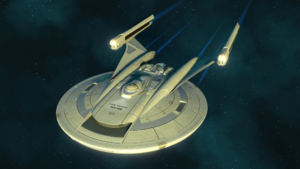| STV Heart of Obsidian (SE-167) | ||||||||||||||

| ||||||||||||||
| STV Heart of Obsidian (SE-167) | ||||||||||||||
| ||||||||||||||
The USS Heart of Obsidian was an experimental vessel, responsible for many of the early testing of the first Warp 8 Engine. She had a crew of 110 officers and crew with an additional 20 research and propulsion experts.
History
First construction in the year 2169, the design premise was to take the expansive redesign of the NX Class Starship which built the Columbia Class and use it to further warp engine design. She was designed with extensively modular drive and power systems. Every system related to warp drive and power generation were designed to be in a class of their own. The design team was credited with creating a vessel that could, in theory, operate for hundreds of years with minimal need for refitting.

The first test flights with the Warp 8 Engine prototypes were done using a modified Warp 7 engine using the Heart of Obsidian (2174-2179). These flights gave engineers the experience needed to redesign the Warp 7 engine, used in the Daedalus Class Starship, into a new kind of warp drive. Up until 2180 the warp core was a compact device constructed in two halves laterally, injecting matter and antimatter into the center and pumping plasma into the EPS system. In 2180 the first major redesign of what a warp core could be was done, creating a much larger intermix chamber where the high energy plasma flow could be amplified.
In this new warp core design, the warp could could produce electro-plasma at a far higher temperature generating more power for engines and ship systems. The warp engine designs developed on the Heart of Obsidian were directly used as fundamental design components even as late as the Constitution Refit Class in the late 23rd century and even in the warp drive design of the Intrepid Class Starship of the 24th century.
In 2183 the vessel was testing early theoretical designs to explore the ideas which would later become the Transwarp Drive of the USS Excelsior nearly 100 years later. During a drive test, the vessel encountered a previously unknown phenomena of subspace, where a region of subspace instability could be separated into layers of subspace. This unexpected breakthrough came at a cost, as the crew attempted to shut down the drive system, the ship literally vanished into its own warp bubble. No wreckage was ever found, though the flight data recorder and log buoy were later found drifting nearly 2 lightyears away, in different directions. An extensive search was conducted, but neither wreckage nor the vessel were ever found.